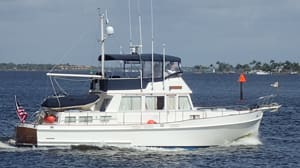Every morning, I awaken to Hawaiian music that provides me with a smooth transition from deep sleep to facing the day. This sure is more pleasant than the shrill alarm that used to scare me awake and have my heart pumping. I suppose we are predisposed to be on guard when an alarm sounds because it usually portends something bad has happened.
On board our trawlers, especially underway, we have a lot of systems running simultaneously and it is not easy to keep track of every detail. We have displays and gauges to provide pressures and temperatures so that we can measure and determine if we are operating in the norm. All is well until something falls out of the proper threshold and then we get a warning, typically in the form of an audible alarm. Boat alarms have a little more volume so that the announcement can be heard over the thrumming of the engines. Every system alarm has a distinctive sound and one of the first things you will quickly understand is matching the alert noise with the specific equipment making the signal.
One of the first training steps I like to review with a person who has just purchased a new or used trawler is a controlled “concert” in which we set off the alarms so that we know what the sound is indicating as well as how to respond to the mute or reset to clear the announcement.
 |
|
A safety panel with lights for indicating alarm status. |
Fire and smoke alarms are about the easiest to hear, and they have a “test” button to confirm battery status. Another easy one that you can control is the high water bilge alarm; there is an “auto/off/test” three-way toggle, and the test mode will sound the alarm. It’s good to know that this common alarm is powered by two 9V batteries and wired to the bilge pump switch, so if you don’t hear the alarm during a test, it may be time for new batteries.
On a trawler with active fin stabilizers, most systems are set up to have the hydraulic pump powered from the main engine. If you shut down your engine without first depowering the stabilizers, you will get an alarm — the fins are not getting power from the main and will squawk to let you know. I’d call this one a reminder alert.
In addition to reminders, there are warnings that come both visually and audibly that serve as alarms. On vacuum toilet and holding tank systems, it is common for only one pump to operate at a time. If there is more than one user and one vacuum pump is engaged, a red light will come on at all stations indicating that you cannot flush until it resets and you get a green light (be sure to explain this to your guest up front). Main engines have alarms if the thermostat indicates you have exceeded the safe operating range, and if you have an issue with your oil pressure, a siren will sound.
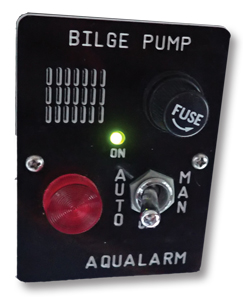 |
|
A bilge pump status unit with both a light and an audible alarm. |
Your navigation and communications suite has a number of built-in adjustments that can be used to set alarms. AIS will sound when in close proximity of other boats. There are programs that will alert you if a target enters your predetermined radar range and/or if your vessel drifts outside of your anchoring parameters while at anchor. When you are on a route and arrive at a pre-programmed waypoint, you may be prompted by an autopilot alarm to accept the change of course to the next waypoint. Autopilot alarms will also chime if they lose their GPS heading. It can get pretty interesting when you have more than one alarm talking to you while underway in the pilothouse — don’t worry, this doesn’t usually happen until 3 a.m. when you are on a solo watch and there are boats approaching and passing you at the same time! Knowing what buttons to push to acknowledge or accept an alarm sound is also important, and it’s best if you have figured this out while safely tied up at the dock instead of while you’re on the job training with a tight passing lane and oncoming traffic.
Nothing will get your attention or surge your adrenaline like an alarm, especially if you have no idea what is wrong or what problem the noise is identifying. Take a breath and calmly try to find out what your trawler is telling you, make the correction, quiet the alarm and proceed with caution.
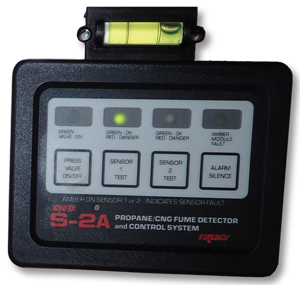 |
|
A propane alarm unit. |
What could possibly go wrong? Don’t ask, since it could be just about anything, and if you think about it too much you will never go anywhere. If you are super sensitive and have deep pockets, Maretron offers a broad scope monitoring program that will give you tank levels, stuffing box temperature — anything you want to track. Whatever you use, think of each alarm as a “heads-up,” an advance notice when something changes. Don’t forget to use your commons senses; if there is an unusual smell, sound or vibration, this could be an early warning sign. Don’t ignore it, as most often things get worse before they get better, and alarms are your first line of defense.
Some common trawler alarms and popular monitoring devices are:
- High temperature warning in engine coolant
- Low oil pressure
- Water in fuel alarm (this will send you a warning if your diesel fuel has water in it)
- Racor vacuum clogged (an alert if your filters are getting dirty and not allowing fuel to screen through)
- Pyrometer temperatures on exhaust runs to check for overheating
- Fire suppression
- Shore power connection and battery level
- Microwave cooking bell/laundry done (these are friendly reminders!)
- Bilge level/high water alarms
- Propane sniffer alarms
- Carbon monoxide/smoke detector alarms
- Security (burglar/intruder alarms and apps that stream live video footage)
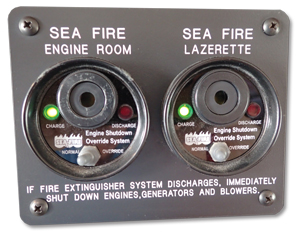 |
|
A fire suppression status panel for monitoring the engine room. |
GOST provides wireless security alarms and cameras that include boat positioning, and Siren Marine offers monitoring for shore power connections (if you lose power it can damage your batteries and spoil your food), bilge levels and more, and is a nice service for remotely monitoring your vessel.
What else can you do? Circumnavigator Bruce Kessler has a rotating orange light similar to an ambulance flasher in his engine room to communicate with anyone doing inspection that they should leave the compartment immediately (this makes sense since alarms can go unheard, especially if you are wearing earmuffs).
Several high-end trawler builders equip their new yachts with profile panels that light up when certain areas are “active.” These at-a-glance panels will tell you if running lights are on, if bilge pumps or freshwater pumps are working, etc., and are prominently mounted overhead in the pilothouse for unobstructed monitoring.
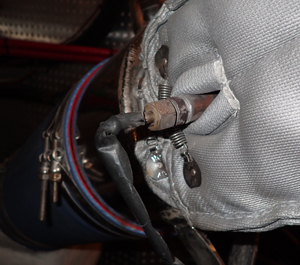 |
|
A probe set into the exhaust system for monitoring exhaust gas temperature. |
An important aspect of “dialing in” your trawler is learning all of your alarms and warning indicators, what they sound like, where they are and how to reset them once you address the issue. Of course, once you figure out how to handle all of these buzzers, what you really want to achieve is the “Garfunkel Equilibrium” — the sound of silence — with a quiet ride that is uneventful and alarm-free as you sail into the sunset on the way to wake up in the Hawaiian Islands…
Jeff Merrill, CPYB, is the president of Jeff Merrill Yacht Sales, Inc.- www.JMYS.com. He is a veteran yacht broker. Merrill is active in the cruising community as a public speaker and writer and enjoys spending time at sea with clients. Jeff is constantly looking for new ideas to improve and simplify the trawler lifestyle. If you have a suggestion or want to get in touch, please email Merrill at: Jeff.Merrill@JMYS.com.

